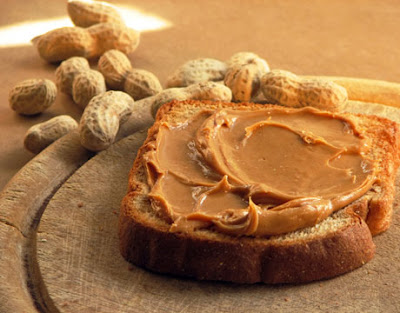Many of us looooove peanut butter - peanut butter and jelly sandwiches, peanut butter cookies, peanut butter on bananas, Reese's peanut butter cups, and the list goes on and on. But nowadays how do we know which peanut butter is the best for us, with all of the different brands, varieties, and marketing schemes?
Walking through the grocery store, there is a huge section in one of the aisles devoted to peanut butter. I kind of find this ridiculous, since you only need two ingredients to make it: peanuts and salt. Though, I don't think any of the jarred peanut butters have only two ingredients. Personally, I like Jif, so I am going to use their products here for comparison, but other brands like Skippy could be compared in pretty much equivalent ways.
Ingredients:
- Regular Jif - Roasted peanuts and sugar, contains less than 2% of molasses, fully hydrogenated vegetable oils, mono- and diglycerides, salt
- Reduced Fat Jif - Peanuts, corn syrup solids, soy protein, sugar, contains less than 2% of molasses, salt, fully hydrogenated vegetable oils, folic acid, niacinamide, pyridoxine hydrochloride, alphatocopheryl acetate, copper sulfate, ferric orthophosphate, magnesium oxide, zinc oxide (whew!)
- Simply Jif - Roasted peanuts, contains less than 2% of fully hydrogenated vegetable oil, mono- and diglycerides, molasses, sugar, salt
- Natural Jif - Peanuts, sugar, palm oil, contains less than 2% of salt, molasses
Personally, looking at this list, I would choose the Natural Jif, or any other peanut butter with the fewest unpronounceable ingredients.
America is focused on losing weight, and low-fat, low-calorie type foods, but I have a problem with reduced fat peanut butter. Yes, some of the fat is gone, but it has been replaced with cheap carbohydrates or chemical fillers used in many processed foods. This means you're trading the healthy fat from peanuts for empty carbs (7g per serving up to 13g per serving of carbs), four times the amount of salt of the natural Jif, and more sugar.
What you want to find is a peanut butter with the bare minimum: peanuts and salt; try to reduce on the oils and ingredients you can't pronounce. Also, try something new like cashew or almond butter. Since these products are a bit more rare, the ones I have seen are more 'natural', with fewer added ingredients. Most importantly, just read the ingredients list - don't be fooled by marketing claims without understanding them fully. Now that my appetite is all worked up, I'm off to go eat some PB&J!














